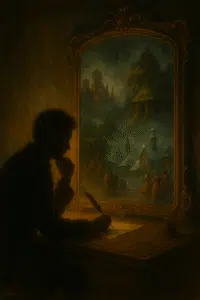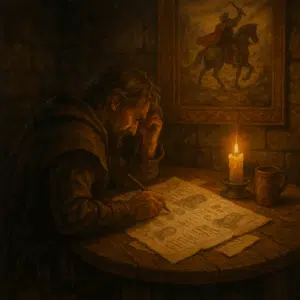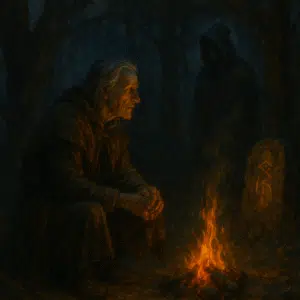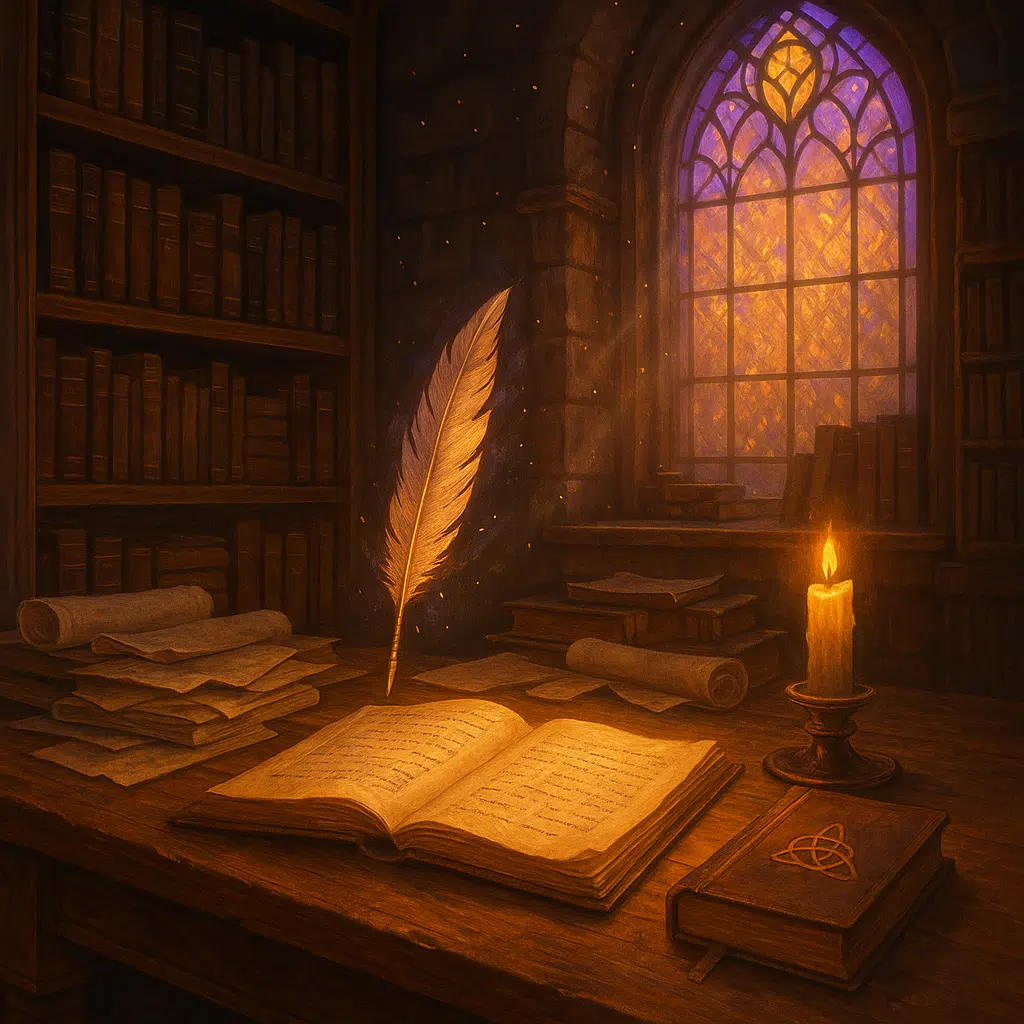From the Private Journals of Sir Alaric Veyrand
22nd Day of Goldleaf, Year 2742 of the High Crown
The morning mist clung to the highland ridges as Quill and I began our ascent toward Dornview, each wingbeat carrying us higher above valleys that had shaped every year of my seven and fifty summers. The ancient chambers beneath Sunwatch Rise—only a week behind us now—had taught me something uncomfortable about the assumptions a man carries about his own homeland. I found myself approaching these familiar peaks with the peculiar nervousness of someone who had just learned he might have been blind to half of what he was seeing.
The transition struck me more forcefully than it should have. Where Kalene nestled in its protective embrace of highland valleys, here the wind ruled everything—landscape, architecture, the very rhythm of daily life. The air thinned with each of Quill’s powerful strokes, carrying conversations I had never learned to understand. My gryphon read the thermal currents with an expertise that had always humbled me, his tawny feathers adjusting to crosswinds that would have battered a lesser flyer senseless. The trust between us, built over decades of partnership, felt more precious here where the sky itself seemed to test every creature that dared traverse it.
Through shifting veils of morning fog, the Great Watchtower of Dornview emerged like something that had grown from the mountain rather than been built upon it. The same highland granite that formed these peaks rose in mathematical precision, its observers’ platforms positioned to command views that I suspected stretched beyond our own borders into kingdoms I had only read about in Brotherhood dispatches. What I had always taken for decorative banners festooning its heights revealed themselves, even at this distance, as something more complex—fabric arrays in patterns that spoke of purpose rather than mere ornament.
Lady Aelwyn would have stopped me right here, I realized with a familiar pang of loss. “What do you see, Alaric, and what are you assuming?” she would have asked, that gentle correction that had shaped my thinking since before I’d reached manhood.
The village below seemed designed entirely around the business of watching. Every building positioned to maximize sightlines, every pathway calculated for swift access to the tower complex. The people moved with an alertness I had noticed in Kalene’s observers but never truly understood—a quality of attention that suggested they were always listening to something the rest of us missed.
Elder Magnus Skywatch awaited us at the tower’s base, his weathered hands clasped behind his back as he watched our descent with eyes that seemed to hold fragments of the very sky. I had known Magnus for decades—he had been present at countless gatherings at the Veyrand estate—but approaching him now in his own domain, I felt the peculiar vulnerability of a scholar about to discover the edges of his expertise.
“Sir Alaric,” he greeted me as Quill settled with barely a whisper against stone. “Welcome to Dornview. I trust the ascent proved instructive?”
The formal courtesy carried undertones I was only beginning to recognize—the polite challenge of one expert measuring another. “Indeed, Elder Magnus,” I replied, offering the traditional highland greeting. “Though I suspect I may have been observing without comprehending.”
His weathered face shifted into what might have been approval. “An honest beginning. Your bird reads the currents well—better than some of our younger watchers, I’d say.” He paused, his gaze shifting to some atmospheric detail I could not detect. “You’ve arrived at an interesting time. We’re expecting a three-day blow to move through, starting tomorrow evening.”
The automatic response troubled me. I found myself glancing at my instruments—their readings showed nothing but fair weather ahead. Atmospheric pressure stable, wind patterns indicating continued clear conditions, my carefully calibrated equipment suggesting several days of excellent observation weather. The contradiction between my mechanical certainty and Magnus’s casual prediction left me oddly unsettled.
“Your instruments show clear skies, no doubt,” he continued, noting my gesture. “Fine devices, those. Valdris craftsmanship, if I’m not mistaken? We had a visiting scholar two summers past with similar equipment from Master Valdris’s atelier.”
“Indeed,” I managed, uncertain whether his observation carried approval or gentle correction.
“Excellent for precise measurement,” Magnus said, beginning to walk toward the tower base. “Though they sometimes miss the subtler conversations the atmosphere conducts with itself. The wind has its own language, you see—one that requires different ears than most of us possess.”
What I had taken for simple decorative streamers revealed themselves as instruments of remarkable sophistication as we approached the tower’s entrance. Different colors, weights, and weaves created three-dimensional displays that responded to atmospheric conditions in ways my mechanical devices seemed unable to detect. The banners moved with fluid intelligence that spoke of centuries of refinement, each flutter and twist carrying information I was only beginning to suspect existed.
“Chief Watcher Elara will be expecting you at the fourth platform,” Magnus said, indicating ascending walkways that spiraled up the tower’s interior. “She’s eager to demonstrate our methods—and perhaps learn something of yours in return.” He paused at the threshold, fixing me with those sky-holding eyes. “Knowledge shared is knowledge doubled, as we say here. Though sometimes we must first admit what we do not know.”
The words settled in my chest with uncomfortable weight. How many assumptions about my own expertise might this week challenge? As Quill settled himself in what was clearly a purpose-built gryphon rest—designed by people who understood the needs of aerial companions—I gathered my equipment and began the ascent toward whatever lessons awaited.
The stone steps, worn smooth by generations of observers, seemed to carry me toward an understanding I had not known I lacked.
Day of Goldleaf, Year 2742 of the High Crown
The ascent through the watchtower proved more humbling than I had anticipated. Each platform revealed observation equipment of increasing sophistication, though none resembled the familiar brass and crystal instruments that had served me faithfully for decades. What I had mistaken for decorative elements revealed themselves as precision devices whose function I could only begin to guess at.
Chief Watcher Elara Farseeing awaited me at the fourth platform, her attention fixed on a complex array of fabric banners that danced in patterns I found myself studying with the uncomfortable intensity of a scholar confronting his own ignorance. She turned as my footsteps announced my arrival, her weathered face bearing the particular alertness I had noticed in all the tower’s inhabitants—as though she were simultaneously present in our conversation and attending to atmospheric conversations I could not hear.
“Sir Alaric,” she greeted me with the formal courtesy that marked highland professional interactions. “Elder Magnus mentioned you’ve brought Valdris instruments for weather observation. I confess myself curious about their precision—we receive few opportunities to compare methodologies up here.”
I produced my barometric measuring device, its polished brass catching the morning light filtering through the platform’s wind-screens. “Indeed, Master Valdris’s craftsmanship has served me well across many expeditions. The pressure readings prove remarkably consistent, and the crystal resonance chambers detect atmospheric changes with precision I’ve found reliable.”
Elara examined the device with the respectful attention one expert pays another’s tools, her fingers tracing the calibration marks with obvious appreciation. “Beautiful work,” she murmured. “The resonance principle particularly elegant. Though I suspect it responds more slowly than our methods require up here.”
The observation struck me as oddly specific. “How so?”
She gestured toward the banner arrays, their complex dance suddenly seeming less random and more purposeful. “Highland weather changes faster than lowland patterns—sometimes within minutes rather than hours. Your device would catch the shifts, certainly, but perhaps too late for the decisions we’re required to make.”
As if summoned by her words, a gust of wind set the banners into more agitated motion. My instruments registered steady pressure, clear skies, and continued fair weather. Yet something in Elara’s posture suggested she was reading different messages entirely.
“The fabric weights,” I ventured, attempting to demonstrate scholarly engagement rather than mere confusion. “Different responses to pressure variations?”
“Pressure, temperature, humidity gradients, wind shear patterns,” she confirmed, her attention shifting between banner sections with practiced efficiency. “But more than that—the combinations tell us about atmospheric instability your instruments might not detect until the changes become dramatic.”
I found myself making rapid notes, sketching banner positions and attempting to correlate their movements with my mechanical readings. The exercise proved frustratingly inconclusive—where my devices showed stability, the fabric arrays suggested approaching turbulence that remained invisible to my trained eye.
The afternoon brought our descent to investigate Oakspire’s ancient groves, Quill carrying us through air currents that seemed to grow more complex as we approached the forested ridges. What I had always taken for natural tree growth revealed itself as something far more deliberate upon closer examination.
The Spiral Grove arranged itself in patterns that spoke of astronomical sophistication, each massive oak positioned with precision that suggested centuries of careful planning. Grove Keeper Daven Spiralwatch met us at the forest edge, his manner carrying the quiet confidence of someone whose expertise had never required outside validation.
“Sir Alaric,” he greeted me, inclining his head with highland courtesy. “Word travels quickly among the ridges. Elara mentioned you’re documenting our weather-reading methods?”
“Indeed,” I replied, attempting to match his unassuming tone. “Though I confess myself impressed by the complexity of your traditional approaches. The banner arrays demonstrate sophistication I had not anticipated.”
Daven’s weathered hands gestured toward the grove’s spiral arrangement. “Different tools for different purposes. The banners read the sky’s immediate intentions, but the trees…” He paused, studying the ancient oaks with obvious affection. “The trees know weather three days hence.”
The statement struck me as the sort of folklore I had learned to approach with respectful skepticism. Yet something in his matter-of-fact delivery suggested practical knowledge rather than mere tradition.
“How so?” I asked, producing my journal to record his explanation.
“Root systems,” he said simply, leading me deeper into the grove. “Extend far below ground, reach into water tables that reflect atmospheric pressure changes days before surface conditions shift. The trees respond to what’s coming, not what’s here.”
We spent the remaining daylight hours documenting the grove’s layout, measuring distances between trees and recording their orientations relative to astronomical markers. My instruments detected nothing unusual—standard highland oak forest with healthy growth patterns and typical seasonal characteristics. Yet Daven moved among the trees with the easy familiarity of someone reading a familiar text, occasionally pausing to touch bark or examine leaf arrangements with obvious purpose.
“Strange thing,” he mentioned as evening shadows began lengthening through the grove. “The trees have been restless these past two days. Sap flow patterns changing, branch positions shifting. Usually means significant weather approaching within seventy-two hours.”
I glanced at my instruments once more—pressure steady, atmospheric conditions stable, no indication of approaching storms. Yet both Elara’s banners and Daven’s trees seemed to be anticipating changes my devices could not detect.
The ride back to Dornview provided time to wrestle with the uncomfortable recognition that my week among the highland observers might challenge more assumptions than I had prepared to question. Lady Aelwyn’s voice echoed in memory: “True scholarship requires the courage to discover we have been wrong, Alaric. Particularly about matters we thought we understood completely.”
As the Great Watchtower came into view, its banner arrays still dancing their complex atmospheric conversations, I found myself wondering what other conversations I had been failing to hear during my seven and fifty years among these highland peaks.
24th-25th Day of Goldleaf, Year 2742 of the High Crown
Wednesday morning brought crystalline skies that mocked every prediction the highland observers had made. My instruments sang with satisfaction—barometric pressure steady as cathedral stone, wind patterns gentle and consistent, atmospheric conditions suggesting days of fair weather ahead. Yet as Quill and I approached the Great Watchtower for our third day of documentation, something in the quality of light troubled me in ways I could not articulate.
Elder Magnus awaited us at the tower’s base, his attention fixed on atmospheric details that remained invisible to my trained eye. The wind-banners hung in patterns that seemed increasingly agitated despite the morning’s apparent calm, their complex dance speaking a language I was only beginning to suspect existed.
“Your instruments reading clear?” he asked without preamble, though something in his tone suggested he already knew the answer.
“Indeed,” I replied, producing my barometric device to confirm the reading. “Steady pressure, minimal atmospheric disturbance, fair conditions extending several days ahead.”
Magnus nodded, but his expression carried the particular patience of someone whose expertise had learned to accommodate others’ limitations. “Interesting. Elara’s been tracking pressure differentials since before dawn. The banners suggest we’ll see the first disturbances by evening, with significant deterioration through tomorrow.”
The contradiction between mechanical certainty and traditional prediction left me studying the tower’s fabric arrays with growing frustration. Where my instruments detected stability, the banners indicated approaching chaos that my academic training insisted could not exist.
Chief Watcher Elara joined us at the fourth platform, her attention divided between traditional observations and my mechanical readings with the professional courtesy of someone humoring a colleague’s unfamiliar methods.
“The pressure gradients remain subtle,” she explained, indicating banner sections that seemed to flutter with purposeful urgency. “Your devices measure atmospheric weight accurately, but they cannot detect the micro-variations that precede significant changes. These fabric arrays respond to pressure differences across much smaller distances and shorter time periods.”
I found myself sketching furiously, attempting to correlate banner movements with instrumental data that refused to acknowledge their warnings. The exercise proved increasingly frustrating as the morning progressed—my devices maintaining their confident predictions of continued fair weather while the traditional indicators suggested approaching storms.
“The difficulty,” Elara continued with scholarly patience, “lies in understanding that highland weather systems develop differently than lowland patterns. The elevation creates atmospheric instabilities that manifest hours or even days before ground-level instruments detect them.”
By midday, my confidence in mechanical precision began wavering as subtle changes crept into the atmospheric conditions. A quality of light that seemed somehow thinner, wind patterns that carried hints of turbulence my instruments still could not measure, pressure variations so slight my devices dismissed them as insignificant fluctuations.
Thursday brought vindication for traditional methods that humbled my academic certainty more thoroughly than I cared to admit. The morning sky, still clear according to my instruments, carried tensions that the highland observers read with casual expertise. Elara’s banner arrays now danced with unmistakable urgency, their complex patterns speaking of atmospheric disturbances approaching faster than my devices could detect.
“The pressure differentials are accelerating,” she explained, indicating fabric movements that seemed to respond to forces I could not measure. “Within six hours, we’ll see the first significant weather changes. By evening, conditions will become dangerous for travel through the exposed ridges.”
My instruments, consulted with increasing desperation, continued their stubborn insistence on fair weather. Pressure readings remained stable, wind patterns showed minimal variation, atmospheric conditions suggested continued clear skies extending through the following week. Yet something in the quality of air itself seemed to argue against their mechanical certainty.
“The critical understanding,” Elara said, noting my frustrated examination of device readings, “lies in recognizing that atmospheric pressure changes travel faster than the actual weather systems. These banners detect the pressure waves that precede storm development, sometimes by days.”
She guided me through the complex interpretation of fabric arrays, explaining how different weights and weaves responded to atmospheric variations my instruments measured too slowly or not at all. The education proved both enlightening and profoundly humbling—decades of confident reliance on mechanical precision confronted by traditional methods that demonstrated superior sensitivity to local conditions.
As afternoon progressed, subtle changes began creeping into even my instrument readings. Pressure variations too slight for concern according to my training, wind shifts barely registering on mechanical scales, atmospheric tensions that seemed negligible by lowland standards. Yet Elara read these minor fluctuations with the fluency of someone interpreting familiar text.
“Highland weather develops vertically,” she explained, gesturing toward peaks that seemed to pierce atmospheric layers I could not see. “Changes begin at altitude and cascade downward, creating pressure waves that travel much faster than the actual storm systems. By the time ground-level instruments detect significant variations, the dangerous conditions are often only hours away.”
The lesson struck me with uncomfortable force. My academic training had prepared me for gradual atmospheric transitions detectable by mechanical measurement, not the rapid highland changes that required different observational methods entirely. The realization that my expertise might prove inadequate for local conditions challenged assumptions I had carried for decades.
By evening, atmospheric tensions had escalated beyond what my instruments could dismiss as insignificant variation. Pressure readings showed the first meaningful fluctuations, wind patterns carried hints of instability, and atmospheric conditions suggested approaching changes that aligned with traditional predictions made days earlier.
The wind-banners now danced with unmistakable urgency, their complex movements speaking of storms approaching with the inevitability Elara had predicted when my devices still insisted on continued fair weather. The vindication of traditional methods over mechanical precision left me confronting the uncomfortable recognition that expertise took forms I had not anticipated.
“Tomorrow,” Elara said as we secured equipment against increasingly restless atmospheric conditions, “we’ll demonstrate how banner readings integrate with instrument data for comprehensive weather analysis. Your devices provide excellent precise measurement—when combined with traditional sensitivity to local patterns, they become even more valuable.”
The prospect of collaborative methodology appealed to my scholarly instincts, though it required accepting that my confident expertise represented only partial understanding of highland atmospheric conditions. As evening settled over the watchtower, wind-banners speaking their urgent atmospheric languages while my instruments finally began registering the changes traditional methods had predicted days earlier, I found myself questioning how many other conversations I might have been failing to hear during my decades among these highland peaks.
The storm approaching from the western peaks promised to test more than weather prediction methods—it would challenge the very foundations of how I understood the relationship between academic knowledge and traditional wisdom.
25th Day of Goldleaf (Evening), Year 2742 of the High Crown
The emergency signal reached us as dusk settled over the Great Watchtower, its piercing horn echoing across ridges already showing the first signs of approaching turbulence. Signal Captain Roden Beaconkeeper appeared at the observation platform with the controlled urgency of someone bearing news that demanded immediate decision.
“Supply convoy from Marridge,” he reported, his words carrying the crisp precision required for highland emergencies. “Twenty pack animals loaded with winter provisions for the eastern settlements. They’ve reached the Windgap Pass and request immediate weather guidance for the overnight journey to Thornhaven.”
My stomach tightened with sudden understanding. The Windgap Pass—an exposed ridge route that required eight hours of careful travel through terrain that offered no shelter from highland storms. Twenty animals carrying supplies essential for communities facing winter isolation, their handlers trusting whatever weather assessment we provided to guide decisions that could mean survival or disaster.
Elara studied her wind-banners with focused intensity, their agitated dance now speaking of atmospheric conditions that had accelerated beyond what my instruments were prepared to acknowledge. “The pressure differentials are steepening rapidly,” she said, her voice carrying the weight of experience. “Within four hours, we’ll see the first significant wind shear. By midnight, conditions through the pass will become lethal.”
I consulted my instruments with growing desperation, their readings still suggesting marginal but manageable weather conditions. Barometric pressure showed continued stability with only minor fluctuations, wind patterns indicated increasing but not dangerous velocities, atmospheric measurements suggested challenging but not impossible travel conditions through the night hours.
“My devices suggest a narrow window,” I said, hearing uncertainty creep into my own voice. “Pressure readings indicate weather changes approaching, but not severe enough to prevent careful passage. Wind velocities remain within acceptable limits for experienced highland travelers.”
The contradiction between mechanical measurement and traditional prediction created a moment of profound professional crisis. Two decades of academic training insisted that precise instrumental data provided more reliable guidance than traditional interpretation of fabric movements. Yet three days of documentation had demonstrated the superior sensitivity of highland observation methods to local atmospheric conditions.
“Sir Alaric,” Roden said with diplomatic caution, “the convoy requires definitive guidance within the hour. They can shelter at Windgap Station through tomorrow if conditions warrant delay, but the decision affects winter provisions for three settlements.”
The weight of responsibility settled in my chest like lead. Real consequences for highland communities depending on weather assessment that balanced mechanical precision against traditional wisdom. Lives and winter survival hanging on expertise I was only beginning to understand might prove inadequate for local conditions.
Elara’s attention remained fixed on atmospheric signs I could not interpret, her weathered hands tracking pressure changes through fabric movements that responded to forces my instruments measured too slowly. “The banner patterns indicate severe conditions developing faster than normal highland patterns,” she said quietly. “I’ve seen similar configurations twice in thirty years—both times resulted in emergency rescues from the pass.”
Yet my instruments continued their stubborn insistence on manageable conditions, their mechanical certainty arguing against traditional predictions that seemed increasingly urgent. Academic training demanded reliance on measured data over interpretive methods that remained beyond my full comprehension.
“The critical question,” I said, wrestling with professional obligations that seemed to demand impossible choices, “lies in determining which assessment serves the convoy’s safety more effectively.”
The evening star brightened over peaks already showing the first veils of approaching weather, atmospheric tensions building toward decisions that would test more than meteorological accuracy. In the growing darkness, wind-banners danced their urgent warnings while my instruments provided confident readings that traditional wisdom suggested might prove catastrophically inadequate.
The convoy awaited guidance that would determine whether twenty animals and their precious cargo faced safe passage or highland disaster.
26th Day of Goldleaf, Year 2742 of the High Crown
Dawn broke with deceptive clarity over the highland peaks, morning light revealing conditions that seemed to mock the urgency of traditional weather predictions. My instruments, consulted with the desperate hope of a scholar seeking vindication, continued their confident assessment of manageable travel conditions. Yet something in the quality of light itself suggested atmospheric tensions building beyond what mechanical precision could adequately measure.
The convoy’s situation had deteriorated overnight. A second messenger arrived with first light, reporting that delays in their original schedule meant winter provisions for Thornhaven, Eastridge, and Millbrook now depended entirely on successful passage through Windgap today. Three communities facing potential starvation if supplies failed to arrive before the highland passes became impassable for the season.
“Twenty-seven souls in those settlements,” Signal Captain Roden reported with the grim precision required for highland emergencies. “Mostly elderly folk and children who remained when the younger families departed for lowland work. They’ve provisions for perhaps ten days without this convoy.”
Chief Watcher Elara stood among her wind-banner arrays, reading atmospheric messages with the fluency of someone whose expertise had guided highland survival for decades. The fabric movements had escalated overnight into patterns I now recognized spoke of severe weather approaching with velocities that traditional methods could predict but my instruments still failed to acknowledge.
“The pressure differentials are steepening beyond normal highland patterns,” she said, her voice carrying thirty years of atmospheric observation. “Within three hours, wind velocities through the pass will exceed safe travel limits. The storm system is developing faster and more severely than typical highland weather.”
My barometric devices, examined with increasing desperation, showed pressure variations that remained within acceptable ranges according to academic training. Wind measurements indicated increasing velocities but not beyond limits experienced highland travelers could manage. Atmospheric conditions suggested challenging but not impossible passage for a carefully managed convoy.
Yet Elder Magnus joined us at the observation platform with news that challenged instrumental confidence more directly than theoretical disagreement. “The Harn herds have been moving since before dawn,” he reported. “All heading toward sheltered valleys, abandoning high pastures despite excellent grazing conditions. That behavior typically precedes severe weather by six to eight hours.”
The natural world itself seemed to be reading atmospheric signs my instruments could not detect, responding to weather patterns that remained invisible to mechanical measurement. Decades of observing highland animals had taught me to respect their instinctual understanding of environmental conditions, yet accepting their warnings meant trusting traditional knowledge over academic expertise.
“Sir Alaric,” Elara said with the diplomatic courtesy that marked professional disagreement, “your instruments provide excellent precision for gradual weather development. Highland storms, however, often manifest through vertical atmospheric cascades that create dangerous conditions faster than ground-level devices can detect.”
The moment of decision arrived with a messenger’s horn echoing across the ridges—the convoy requesting final authorization for immediate departure or orders to shelter for an additional day. Twenty pack animals loaded with winter survival supplies, their handlers trusting whatever assessment we provided to guide choices between community starvation or potential disaster in exposed highland passes.
I found myself standing before wind-banner arrays that danced with urgent atmospheric conversations, their complex movements speaking of pressures and instabilities that my mechanical devices dismissed as insignificant variation. Three days of documentation had demonstrated their superior sensitivity to local conditions, yet decades of academic training demanded reliance on measured data over interpretive methods.
“The professional responsibility,” I said, wrestling with expertise that seemed suddenly inadequate for decisions affecting highland survival, “requires assessment based on available evidence and experience.”
Elara nodded with understanding that carried no judgment. “Indeed. And the evidence includes both instrumental precision and traditional sensitivity to local atmospheric patterns.”
The critical moment arrived as atmospheric tensions escalated beyond what my instruments could continue dismissing. Pressure readings showed the first significant fluctuations, wind patterns carried hints of instability, conditions suggested approaching changes that aligned with predictions traditional methods had been making for days.
Yet the wind-banners indicated weather development accelerating beyond even normal highland patterns, their agitated movements speaking of storm systems building with velocities that threatened to overwhelm the pass within hours rather than the gradual deterioration my instruments suggested.
“The convoy requires immediate guidance,” Roden announced as the morning star brightened over peaks showing the first veils of approaching weather.
I studied my instruments one final time, their mechanical certainty arguing for manageable conditions against traditional warnings that had proved consistently accurate throughout the week. The decision balanced academic confidence against highland wisdom, with three communities’ winter survival depending on choosing correctly between competing forms of expertise.
“Signal the convoy to shelter at Windgap Station,” I said, feeling the words carry weight beyond mere weather assessment. “Atmospheric conditions indicate severe storm development within six hours. The pass will become impassable by afternoon.”
The message departed with signal fire precision, carrying recommendations based on traditional knowledge that contradicted my instrumental confidence. Within minutes, response smoke confirmed the convoy’s acceptance of shelter orders, twenty animals and their precious cargo seeking protection from weather my devices still suggested they might have survived.
By noon, vindication arrived with a violence that humbled my academic certainty more thoroughly than years of scholarly debate. The storm struck the highland ridges with fury that transformed landscape into nightmare, wind velocities that would have killed exposed travelers, atmospheric pressures that plummeted beyond what my instruments had predicted possible.
Through the watchtower’s protected observation ports, we watched conditions that would have destroyed the convoy utterly had they attempted passage based on my instrumental assessment. The Windgap Pass became a corridor of death, wind-driven debris and pressure changes that would have scattered pack animals and handlers across highland valleys like autumn leaves.
“Traditional knowledge,” Elara said as we documented storm development that exceeded my mechanical predictions by catastrophic margins, “represents centuries of accumulated observation refined through survival necessity. Your instruments provide excellent precision when combined with local understanding of atmospheric patterns.”
The storm raged through the afternoon with intensities that vindicated traditional wisdom while demonstrating the inadequacy of purely academic approaches to highland weather prediction. My devices, finally registering conditions they should have detected hours earlier, provided precise measurement of catastrophic failure to understand local atmospheric development.
As evening approached and storm conditions began moderating toward the patterns traditional methods had predicted, I found myself documenting not merely weather phenomena but the humbling recognition that expertise took forms my academic training had not prepared me to recognize or respect.
The convoy sheltered safely at Windgap Station, their precious cargo protected by decisions based on traditional knowledge that had proved superior to instrumental precision for conditions that mattered most—highland survival itself.
26th Day of Goldleaf (Afternoon), Year 2742 of the High Crown
The storm’s fury exhausted itself by late afternoon, leaving behind atmospheric conditions that finally matched what my instruments should have detected hours earlier. Through the watchtower’s observation ports, we watched the Windgap Pass emerge from veils of driven snow and debris, its rocky surfaces scoured clean by winds that would have killed exposed travelers within minutes of the weather’s true arrival.
Chief Watcher Elara moved among her wind-banner arrays with the quiet satisfaction of someone whose expertise had once again proved itself under conditions where failure meant death. The fabric indicators now showed moderating atmospheric pressures, their complex dance settling into patterns that spoke of clearing skies and returning stability.
“The pressure differentials are stabilizing,” she reported, though her attention remained fixed on atmospheric signs I was only beginning to learn to read. “We’ll see continued clearing through tomorrow, with fair conditions returning by Sunday morning.”
My instruments, consulted with the chastened humility of recent education, finally registered readings that aligned with traditional predictions made days earlier. Barometric pressure showed dramatic changes that should have been detectable far sooner, wind patterns indicated velocities that exceeded safe travel limits by catastrophic margins, atmospheric measurements confirmed conditions that would have destroyed the convoy completely.
“The integration of methodologies,” I said, making careful notes about pressure variations my devices had missed until they became overwhelming, “suggests possibilities for enhanced weather prediction that combines instrumental precision with traditional sensitivity to local patterns.”
Elder Magnus joined us as afternoon light revealed the storm’s aftermath across highland ridges, his weathered face carrying approval that meant more than formal academic recognition. “Knowledge shared is knowledge doubled,” he said, invoking the highland saying with obvious satisfaction. “Your instruments provide excellent measurement capability—when guided by traditional understanding of what to measure and when.”
The collaborative potential struck me with force equal to the morning’s professional humiliation. My devices offered precision that traditional methods could not match, while highland observation techniques detected atmospheric changes my instruments missed entirely. Neither approach alone provided adequate understanding of conditions that required both sensitivity and accuracy for effective prediction.
“The wind-banners detect pressure variations hours before instruments register significant changes,” Elara explained, guiding me through interpretation methods that combined traditional observation with mechanical measurement. “But your devices quantify those changes with precision that helps determine exactly when conditions will become dangerous.”
We spent the remaining daylight hours documenting integrated techniques that merged highland wisdom with academic methodology. My instruments, when guided by traditional indicators toward relevant atmospheric phenomena, provided measurements that enhanced rather than replaced traditional knowledge. The banners detected changes my devices missed, while mechanical precision quantified conditions traditional methods could sense but not measure exactly.
“The critical understanding,” I noted while recording collaborative procedures, “lies in recognizing that different observational methods complement rather than compete with each other. Traditional sensitivity identifies what requires measurement, while instrumental precision determines degrees of danger.”
Signal Captain Roden arrived with confirmation that the convoy remained safe at Windgap Station, their winter supplies protected by decisions based on traditional knowledge that had proved superior to purely academic assessment. The message carried gratitude from three highland communities whose survival depended on weather prediction that prioritized practical accuracy over theoretical precision.
“Twenty-seven souls,” he reported with highland understatement, “who’ll spend winter warm and fed because traditional wisdom guided instrumental measurement toward correct conclusions.”
The professional lesson settled in my chest with weight that extended beyond meteorological methodology. Academic expertise, however precise and carefully developed, remained incomplete without understanding of local conditions that traditional knowledge had refined through centuries of survival necessity. My instruments provided valuable capability, but only when guided by wisdom I had nearly dismissed as mere folklore.
As evening approached and atmospheric conditions stabilized toward the clear weather Elara’s methods had predicted, I found myself documenting not merely technical procedures but a fundamental shift in understanding expertise itself. The week among highland observers had taught me that knowledge took forms my academic training had not prepared me to recognize, much less respect.
“The methodology for the broader expedition,” I wrote in careful notes intended for future reference, “must incorporate traditional knowledge systems alongside academic approaches. Effective documentation requires collaborative understanding rather than scholarly assumption of superior expertise.”
Chief Watcher Elara reviewed my integration notes with professional approval, her weathered hands tracing instrumental readings that finally aligned with traditional predictions. “Your approach honors both precision and wisdom,” she said with highland courtesy that carried genuine respect. “The combination serves Highland survival more effectively than either method alone.”
26th Day of Goldleaf (Evening), Year 2742 of the High Crown
The Eagle’s Perch welcomed us with warmth that seemed more precious after witnessing the storm’s fury through the watchtower’s protected windows. The tavern’s hearth cast dancing shadows across stone walls while highland ale provided comfort that my instruments, no matter how precisely calibrated, could never measure or predict.
I spread my week’s documentation across a corner table, pages filled with sketches of wind-banner configurations alongside careful measurements of atmospheric phenomena I had learned to detect only through traditional guidance. The integration struck me as more profound than mere technical advancement—it represented a fundamental evolution in how I approached the very concept of expertise.
“Strange,” I murmured to Quill, who had settled beside the fire with obvious satisfaction, “how one can spend seven and fifty years believing himself competent in weather observation, only to discover he’d been reading half the conversation.”
The wind-banners outside The Eagle’s Perch now spoke languages I could begin to interpret, their movements carrying atmospheric messages that complemented rather than competed with my instrumental readings. The collaborative methodology developed during the storm’s testing promised to serve the broader expedition in ways I had not anticipated when departing Kalene with confident academic assumptions.
My journal entry for the evening recorded more than meteorological techniques. “The highland observers have demonstrated that traditional knowledge represents centuries of accumulated wisdom refined through survival necessity,” I wrote by flickering candlelight. “Academic training provides valuable precision, but only when guided by understanding of what phenomena require measurement and when.”
The broader implications extended beyond weather prediction to the fundamental approach I would take toward documenting Skaldarion’s diverse knowledge systems. Every community possessed expertise developed through generations of local experience, wisdom that my academic training alone could neither recognize nor adequately record.
“Lady Aelwyn would have found this week instructive,” I reflected, imagining my mentor’s satisfaction at seeing traditional knowledge prove its worth against scholarly assumptions. Her voice echoed across memory: “True scholarship requires the courage to discover we have been wrong, particularly about matters we thought we understood completely.”
Through The Eagle’s Perch’s windows, the Great Watchtower stood silhouetted against stars emerging in clearing skies, its wind-banners settling into peaceful patterns that spoke of fair weather returning exactly as traditional methods had predicted. The collaborative framework established during the storm would guide my documentation of remaining highland settlements, then extend to communities across Skaldarion whose local wisdom deserved the same respectful integration I had finally learned to offer.
Tomorrow would bring new settlements and different forms of expertise, but tonight brought the satisfaction of knowledge shared and understanding deepened through collaborative respect rather than academic assumption.






